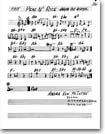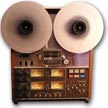now
 Makanda Project
Makanda Project
 Makanda Archive
Makanda Archive
 links
links
 acknowledgments
acknowledgments
 contact
contact
 Makanda Project
Makanda Project
 Makanda Archive
Makanda Archive
 links
links
 acknowledgments
acknowledgments
 contact
contact
the Makanda Archive story
by Joy RosenthalMakanda and I had only been married for 6 months when he died of a heart attack in June 2001. I had moved in with him, and hadn't had time to really explore the contents of all of the closets and cupboards. I don't think even he knew how much music he'd written. When asked, he'd say "over 100 pieces." What an understatement!
Over the next few months, I found his music manuscripts around the apartment -- not only in his studio, but in the file cabinet in the closet here, in an unopened suitcase there, and folders of scores in the kitchen cabinets. It was exciting to find new works - there were so many I'd never heard, never even heard of. There were also hundreds of tapes - cassettes and reel to reels - recordings of his practice sessions, of performances, of workshops with his students. So I was confronted with the daunting task of organizing and preserving this treasure.
What to do? Well, the first thing I did was get help. Two of Makanda's students, Michael Herbst worked with me the first year, and Andy Bemkey and I have been working together since 2002. We started organizing the written music, so we could figure out what there was. We created a file for each tune, putting a copy of each version in the file, including the lead sheets, the arrangements, and, when we had them, sketches from Makanda's notebooks. Some files were only one sheet - some were huge scores. We made a spreadsheet with a little bit of information about each song. This was helpful to keep track of what was copyrighted, so we made sure we registered the whole catalog. Then, we made copies of each manuscript, to be kept in separate places. My brother, Steve Rowland, an independent radio producer and documentarian introduced us to Lloyd Pinchback at the Music Division at the Library of Congress. Lloyd enthusiastically and warmly welcomed us to the Library, and was tremendously helpful in coordinating the deposit of all the archival materials into the Library of Congress. The full catalog has 699 entries and over 437 separate songs. This whole process took about a year (part time).
Then we had the issue of the recordings. I realized that tapes wouldn't last forever, and wanted to make sure we preserved them. Some were reel-to-reel tapes from the 1950s, and the tapes were disintegrating. We decided to transfer each of the tapes of Makanda playing or teaching to CD, to create a digital entity. We had nearly 200 reel to reel tapes, and over 500 cassettes to transfer. The transfer process was long and slow, because, in order to make the cuts between songs on the CDs, it had to be done in real time. Andy did nearly all of the transfers - meticulously, methodically, and lovingly. It actually took about 3 years to complete. We kept a spreadsheet of the recordings, also, again with a brief description of each one. Sometimes we knew who all of the musicians were, sometimes we didn't - so we tried our best to research or figure it out when we could. The Library of Congress now has all of the original tapes along with the CDs in their Recorded Sound Division.
I produced a few concerts of Makanda's music during this period. We had a memorial service for him at St. Peter's Church (the jazz church) on September 16, 2001, with many of his colleagues and former students performing. I'd planned it as a tribute to Makanda, but it turned out to be an evening of Makanda healing us, as it was for many of us the first time venturing out in public after September 11th. In June 2002 we had a concert in Makanda's home town of Boston, which was really a prelude to the Makanda Project. In June 2003, I produced "Eight at Eight," an evening of octet music led by Craig Harris, at Merkin Concert Hall in New York City. In 2004, we produced the album, In the Wind. And in 2005, the Makanda Project really began to take off.
I learned some things about Makanda throughout this process. He often wrote ideas for songs in music composition books, which he used much as a visual artist would use a sketch book. He wrote musical ideas whenever they came to him. I found little slips of paper covered music notation around the house. Once I saw him writing a rhythm on the napkin he got with his soda on an airplane. He created his own system for dating his compositions - 52569 meant May 25, 1969. At some point in the seventies, he must have realized that he needed six numerals instead of five. For instance, if he dated a piece 11778, it wasn't clear if it was written on January 17 or on November 7, 1978. After a while he changed the system so we found. He also went back and worked on things long after they'd been "finished," sometimes even after they'd been recorded. For instance, Corner Time and Turbo Spacey are different names for the same tune. As are Da Da Di Dah and Got My Mind Set on Freedom.
I also learned a bit about how he felt about me. He had a tremendous spurt of creativity in the months we were engaged, and gave his tunes names of anticipation, like Augmented Life, We Are One, Suspense, Sunrise, Echo, Love, Dawn, Rising Mist, and Gentle Waves. He only wrote three tunes after that - one called Tumaridden/ Hileen, a sort of medical description of how his sister, Eileen, was faring (she died of cancer 19 days before Makanda did), and After, which he wrote shortly after Eileen died, five days before he died, for Eileen and his first wife, Charshee.
I am thrilled that John Kordalewski and the Makanda Project are playing Makanda's music now, and I'm always happy to hear when former students of his play his compositions in concert. If you are a musician, I hope you will take one of the lead sheets we offer and play Makanda's songs in public. One day Makanda's tunes will be in the repertoire of jazz standards - they certainly deserve that place at the table!
Joy Rosenthal
New York, NY
October 2007



